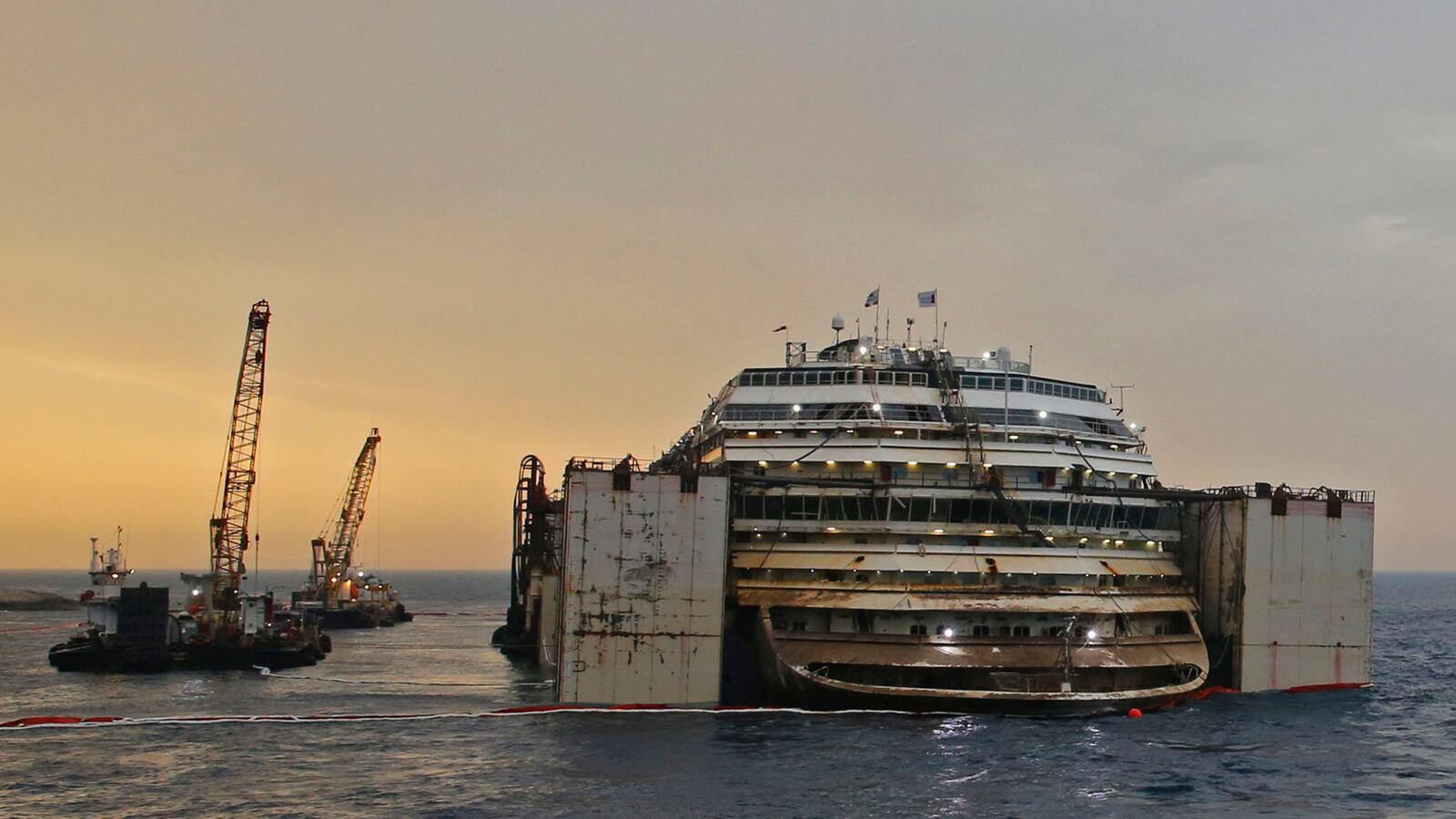It is not uncommon to find vials of blood from venerated martyrs and saints in Catholic churches all across Italy. But inside the church of San Lorenzo in Giglio harbor, Father Lorenzo Pasquotti keeps something slightly different. There, on a wooden shelf dedicated to the January 2012 Costa Concordia shipwreck, is a vial of engine oil taken from the sunken vessel. “The technicians who removed the fuel gave it to me,” Father Pasquotti told The Daily Beast. “It seemed appropriate to have something from the heart of the ship.”
The Costa Concordia, carrying 4,229 passengers and crew, was wrecked on the Tuscan island of Giglio on Friday the 13th in January 2012, after three hours at sea. The ship’s captain, Francesco Schettino, who is facing charges for multiple manslaughter, abandoning ship and causing a maritime disaster, diverted from the planned route to perform a “fly by” or maritime salute to the picturesque island of Giglio, apparently to impress a Moldovan ballerina who was his guest on the ship and who testified at his trial. Thirty-two people died in the accident.
Father Pasquotti’s other mementos in the Costa Concordia shrine include a lifejacket one of the passengers who sought shelter in his church the night of the accident left behind in a pew. His display also includes an oar from a lifeboat, a hard hat to pay tribute to the hundreds of salvage workers, divers, and engineers who have been working an impossible 24-7 shift for the last 30 months to remove the ship from Giglio’s harbor, and various sacramental objects from the ship’s chapel. “It is important to have a point of reference when the ship is gone,” Pasquotti says. “It may seem improbable now, but someday this experience will be behind us.”
Giglio’s mayor, Sergio Ortelli, says that the island will never build an actual shrine to the Costa Concordia other than the church museum and the memorial plaque on the quay wall engraved with the names of the 32 victims. Divers working on the wreck also erected a small memorial near the crash site dedicated to a Spanish diver who died on the job this spring after being crushed by one of the hydraulic lifeboat arms that didn’t deploy when it should have the night of the disaster, and instead deployed when the divers were trying to remove it for the salvage. Instead, the Giglese will commemorate the shipwreck with a prayer service on Jan. 13 every year, and nothing more. “We don’t want to remember the boat,” Ortelli told The Daily Beast. “But we will never forget the victims.”
Giglio may recover from the accident that marred its picturesque shores and disrupted its peaceful lifestyle, but it is no exaggeration to say that the island will never be the same again. Before the Concordia came to town, the local population hovered somewhere between 600 and 900 during the winter months. But for the last two and a half years, more than 500 salvors from 29 countries have taken up residency and upturned their island lifestyle. Before the Concordia, the island shuttered up in late October and opened again in the spring. Now they do business year round, which has been a boon in times of economic crisis. Two full hotels on Giglio port have been rented entirely for two years for the salvage crews and the command center. Before the Concordia, they didn’t even stay open in the winter months.
The bars and restaurants too have flourished despite the fact that they have been forced to serve unthinkable food combinations to cater to the many American, Dutch, and British workers who insist that carbonara pasta should include chicken. They’ve also taken to importing foreign beer and English tea. No one ever used coffee mugs much in Giglio before the salvage crews came to town, but demitasse cups just didn’t quite work so now the coffee bars have adjusted, too.
But more than the superficial alterations one makes to serve a new clientele, the Giglese have opened their hearts to the rugged, almost all male crew who they see not as salvors so much as saviors who will rid them of the wretched wreck. “We aren’t going to be OK when this is over, how can we be?” asks Rosalba Brizzi, owner of Bar Fausto on Giglio port. “This ship has defined us, these salvage people have endeared themselves to us. When they all leave and go home, we will be lost without them.”
The most obvious way for many Giglese to keep a bit of the memory of the Concordia intact without ruining the view is to leave in place the six gigantic underwater steel platforms that were erected to hold the wreck when it was “parbuckled” to an upright position last fall. Costa cruise company, owned by American Carnival Cruises, has promised to return the pristine seabed to its original state, but because the platform pillars are embedded so deep into the bedrock there is no way to pull them out without ruining the entire seabed and potentially fracturing the island’s rocky shores. Instead they plan to cut them apart under water and then saw the pillars off at the base to take the platforms away.
A growing majority of Giglese instead wants to leave the platforms in place to grow an artificial reef to attract divers who might find it fascinating to come dive where the Concordia was shipwrecked. Even Greenpeace and other environmental groups say leaving the platforms intact in situ will be far less harmful to the sea life then cutting them up underwater, which will create a metallic sediment that will be harmful to the schools of fish that have repopulated the wreck site. “Island communities all over the world like ours spend millions of euro to build half the size structures for artificial reefs that are in place here right now from the Concordia,” Roberto Scotta, president of Giglio’s divers consortium, told The Daily Beast. “The pillars are already covered with new growth after just two years. In a decade we could have the most amazing reef and fish in the Mediterranean.”
No matter what happens with the platforms and whether the hotels and restaurants will start closing again for the winter, Giglio will remain scarred from the tragedy. First, from the night the Concordia crashed and more than 4,000 people spilled onto its shores, and now from the loss of the workers who have freed them from the wreck. Roberto Ruggero, whose grandfather owns one of the most popular restaurants in Giglio port, sums it up best. When asked what will happen to Giglio when the ship is gone, he simply draws a giant invisible question mark on the table. “It’s anybody’s guess,” he says. “But we will never be the same again.”





